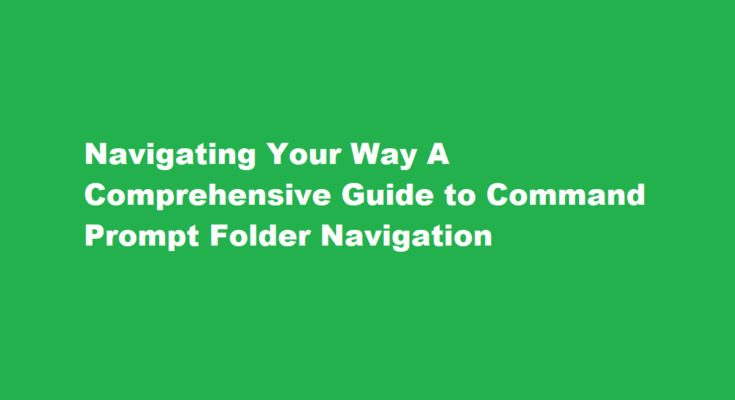Introduction
Command Prompt, or CMD, is a powerful tool that allows users to interact with their computer’s file system and execute various commands. Navigating to a specific folder within CMD can be a fundamental task, especially for those who frequently work with the command line interface. In this article, we will provide you with a detailed guide on how to navigate to a folder in CMD, offering insights, tips, and tricks to make the process smoother and more efficient.
Opening the Command Prompt
Before we dive into folder navigation, let’s start with the basics. To open the Command Prompt on a Windows system, press the “Windows key + R” to open the Run dialog, type “cmd,” and hit Enter. This will launch the Command Prompt window, where you can begin your journey.
Understanding Directory Structure
In CMD, it’s crucial to understand the concept of directory structure. Your computer’s file system is organized hierarchically, with directories (or folders) containing files and subdirectories. Each directory has a path, which is the series of directories and subdirectories leading to it. To navigate successfully, you need to grasp this structure.
Navigating to a Folder
The basic command for navigating to a folder in CMD is “cd,” which stands for “change directory.” To navigate to a specific folder, you should know the folder’s path. Here are some commands you can use:
Absolute Path
To navigate directly to a folder using its absolute path (i.e., the full path from the drive letter), use the following command
“`
cd C:\Path\To\Your\Folder
“`
Replace “C:\Path\To\Your\Folder” with the actual path to your desired folder.
Relative Path
You can also use a relative path, which is a path relative to your current directory. For example, to move one level up from your current directory, use:
“`
cd ..
“`
To enter a subdirectory within your current directory, use
“`
cd SubfolderName
“`
Tab Completion
CMD offers a handy feature called tab completion. When typing a path or folder name, you can press the “Tab” key to autocomplete the directory or file name. This not only saves time but also minimizes the chances of typing errors.
Navigating Between Drives
If you need to switch between different drives (e.g., from C: to D:), use the drive letter followed by a colon
“`
D:
“`
This command will change your current drive to D:.
Viewing Directory Contents
To see the contents of the current directory, use the “dir” command. It will display a list of files and subdirectories within the directory.
Creating and Deleting Directories
While navigating through CMD, you may want to create or delete directories. To create a directory, use the “mkdir” command
“`
mkdir NewFolderName
“`
To delete an empty directory, use the “rmdir” command
“`
rmdir FolderToDelete
“`
Tips for Efficiency
Navigating through CMD efficiently is all about shortcuts and tricks. Here are a few tips to make your experience smoother
a. Use the “cd /d” command to change the drive and directory simultaneously. For example:
“`
cd /d D:\Path\To\Your\Folder
“`
b. To return to your user directory quickly, use the tilde (~) symbol:
“`
cd ~
“`
c. Utilize the “cd /?” command to view the built-in help for the “cd” command, which provides additional options and flags.
Frequently Asked Questions
How do you navigate between folders in cmd?
In the command prompt window, type cd followed by the folder’s name you wish to find. This only works for immediate folders straight after the one you’re in. If you want to go back one directory, type cd .. to go up a level before typing cd to go back to the original option.
What command can we use to navigate to a specific folder?
The cd command allows you to move between directories. The cd command takes an argument, usually the name of the folder you want to move to, so the full command is cd your-directory . Now that we moved to your Desktop, you can type ls again, then cd into it.
Conclusion
Navigating to a folder in CMD is a fundamental skill for anyone working with the command line interface on Windows. By understanding the directory structure, using the “cd” command, and employing efficiency tips like tab completion, you can become a more proficient CMD user. Whether you’re managing files, troubleshooting issues, or automating tasks, these skills will prove invaluable in your journey through the command prompt. So, embrace the power of CMD and navigate your way with confidence and ease.
Read Also : Navigating to Another Page in JavaScript A Comprehensive Guide



